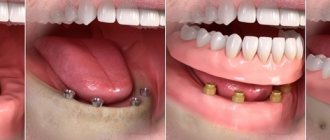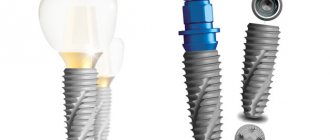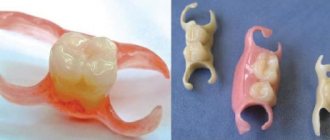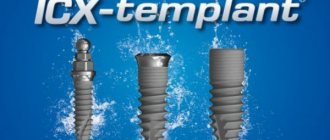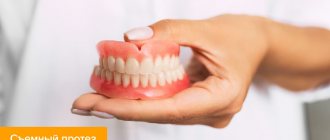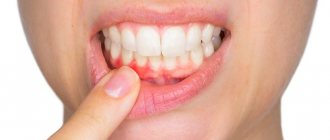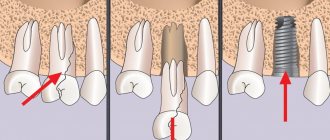Who is the event aimed at:
We invite you to the author's updated course by Dr. Ilya Friedman: Basic course in dental implantology for dentists. “Fundamental principles of successful implantation. Classic and modern concepts of planning and carrying out dental implantation.” This is no longer 4 days, but 5 days, full of theory and practice, small groups and work with the Doctor himself.
Who is the course for? For dentists who are beginning to implant and those colleagues who have already begun to encounter problems for which they cannot find answers on their own.
Prices for dental prosthetics and implants
Full price
The procedure consists of several factors - the status of the dental implantation center, the choice of technology, the number of implanted elements, the brand of the manufacturer of prosthetic systems, as well as additional measures:
- tooth extraction;
- endodontic treatment and complete sanitation of the oral cavity is a mandatory procedure to avoid the occurrence of infectious infections;
- bone tissue augmentation (usually with the traditional implantation method);
- professional teeth whitening and hygiene.
Based on this,
The average cost of dental prosthetics in our clinics is:
- according to the all-on-4 protocol – from 300 thousand rubles.
for one jaw; - prosthetics with the all-on-6 system – from 400 thousand rubles.
for one jaw; - the price of turnkey implantation for one implant plus a zirconium crown – from 115 thousand rubles
; - implantation of one classic implant - from 50 thousand rubles;
- conditionally removable beam prosthetics – from 200 thousand rubles.
The cost of dental services in the best centers not only in Moscow, but also in Russia is higher than in other dental clinics. The main thing for the patient is high quality work, allowing them to use new teeth for as long as possible and without the slightest feeling of discomfort. The quality of work has been tested by time, as evidenced by numerous reviews from patients of our clinics.
Features of the event:
I bring to your attention another updated version of the author's course. Based on the knowledge gained and directions for further development, some of you will take your first steps in dental implantation, some will finally be able to find answers to routine professional challenges, some will discover previously unknown subtleties of the “craft”, some will then he will comprehend the philosophy of dental implantation, higher meanings will become available to him, and he will come close to the pinnacle of mastery.
In any case, if you are reading these lines, it means that the wonderful world of dental implantation with all its classic and modern trends will sooner or later open up to you completely, allowing you to move into a completely unusual quality: an expert implantologist.
I have been walking this road for 27 years now. Thanks to the constant analysis of my attitude to the matter, today I know exactly what mistakes can be avoided along the way, how to learn to pay attention to non-obvious mental, social, psychological, diagnostic, clinical, protocol and other errors and shortcomings that, accumulating, can lead away from desired result for both doctor and patient.
I am grateful to fate that back in 1995, when I first learned about this method of treatment, I was literally mesmerized and bewitched by Dr. Ofir Fromovich, who became my teacher and friend! A man of inexhaustible energy, a true professional, a dental “evangelist”, filled with the goal of popularizing dental implantation among doctors and patients, a tireless worker, he practically “immunized” me with his ideas and enthusiasm.
This led to the fact that in 1997, together with the Teacher, I began active teaching and missionary work. In 1999, the first version of the course appeared. Since then it has developed, expanded, changed - grown with me. Over the 18 years of its existence, this cycle has undergone a large number of editions in accordance with how global dental implantology has developed, how my professional worldview has changed, skills acquired, mistakes made and analyzed. Since 2000, after training in this course, more than 3,500 dentists in different countries began to implant. Proud of it.
I will readily share my experience and knowledge with everyone. I will be glad to help everyone start and continue their confident movement and constant development in the implantology expert environment.
Dr. Ilya Fridman
Fixed prosthetics in the absence of teeth on implants
Innovative implantation protocols used in our implantology centers prove the effectiveness and advantage of installing dentures on abutments over conventional dental prosthetics without implants.
Advantages of complete dental prosthetics with implants:
- Chewing function is restored by more than 95%, while with the installation of bridges and other removable dentures - a maximum of 60%.
- The price of complete dental prosthetics on implants is much lower than installing several crowns on dilapidated teeth and other removable bridge structures.
- Uniform distribution of functional load, which completely eliminates further bone tissue resorption.
- High aesthetics and ergonomics of the non-removable design allow the patient not to feel even the slightest discomfort. Permanent dentures are absolutely identical to natural teeth, both in appearance and in the way they maintain hygiene.
Important!
The patient must understand that the fewer teeth he has and the longer he wears removable orthopedic structures, the faster the bone tissue atrophies.
And in this case, only the latest implantation systems such as “all on six” or “all on four” can help. To answer all questions regarding the use of the ALL ON 4
and
ALL ON 6
, watch the following video:
Event program:
Module 1. Definition of the basic provisions and concepts of implant surgery.
Abstract:
We all learned a little... Do you remember when you came to first grade? What did you study in elementary school?.. That's right! Primer, calligraphy... We were taught to communicate with the world, to understand and perceive the surrounding reality. Basics! Something without which further study of life would be impossible... It was thanks to the initial, fundamental knowledge that further education became progressive and consistent.
It’s exactly the same in mastering dental implantation. If from the first steps in this specialty we do not accept the main rules, basic truths, terminology, definition of basic concepts, the very philosophy of this discipline, then it is unlikely that we will be able to communicate effectively with colleagues, confidently operate and guarantee patients a long-term functional prognosis.
Unconscious misconceptions will haunt us if we do not give ourselves the trouble to understand the most important things with passion. Just one simple example: idle expressions: “dental implantation”, “implants take root” - are absurd in meaning. Believe me, when each of us begins to consult a patient with the thesis that it is not the implant that interacts with the bone, but quite the opposite. After all, a metal object is simply not able to possess the functions of living tissue and does not have any abilities for this, then the whole point of treatment and interaction with the patient will follow the correct and logical path.
On the path to success, we will stop relying on the magical characteristics of our instruments (and implants are the same tools as a probe with tweezers, and a saliva ejector with a chair), and we will begin to pay primary attention to medical logic, reasonable maneuvering within treatment protocols and competent consistency in taking clinical decisions. Agree, only then will both the doctor himself and his ward have real knowledge of the true state of affairs!
We will study most of the fundamental causes of inconsistencies, misunderstandings, misunderstandings, misconceptions, etc., existing in implantology, each putting everything on its own “shelves.” We will begin implanting confidently, minimizing protocol errors, guaranteeing patients the maximum result in all respects.
Evolution of knowledge and perceptions about the success of implantation.
- Types of dental implants.
- Definition of the term “Implant”.
- Purposes of implantation.
- Physiological, anatomical, biological and functional differences between the periodontal complex surrounding the tooth and the peri-implant tissues.
- Biological width, desmosomal, hemidesmosomal connections. Transgingival “health”, pathogenesis of peri-implant cervical defects.
- Biotypes of soft tissues of the oral cavity. Fundamental differences. Implications for prognosis of implantation.
- 30 fundamental differences: “tooth-implant”.
Module 2. Physiology of osseointegration and structure of the jaw bones. Classification.
Abstract:
No matter how healthy, strong, beautiful, capable in all respects a grain of wheat may be, if you throw it to the mercy of fate in clay or simply in dehydrated incapacitated soil, then counting on any result other than a depressing one would be arrogant stupidity, irresponsibility and disrespect, first of all, for one’s time, labor and qualifications.
Similarly, in modern implantology, the prognosis for achieving osseointegration and the quality of bone tissue metabolism are inextricably linked. Contrary to this implication, for some colleagues, a much more natural diagnostic protocol is to search for a site for installation of an implant, rather than eagerly studying the very possibility of osseointegration in each specific case. Let us study these mechanisms and influences in detail.
After all, it is obvious that only with such knowledge, its constant use and improvement, with an understanding of the basics of generation and regeneration of peri-implant tissues, the ability to interpret the results for modifying treatment tactics, the doctor is able to achieve the expected goals.
Finally, it is completely naive to believe that any of the famous brands in Implamir are able to replace the qualifications of a doctor and physiological laws.
Osseointegration.
- Definition. Factors of influence. Conditions of occurrence and preservation.
- Mechanical and biological stability of the implant. Fundamental differences. The mechanism of blood clot retraction (“Blood clot retraction theory”) is the basis for the formation and restoration of bone tissue. Modeling. Remodeling. Life cycle of bone tissue. Understanding the importance of continuity of bone regeneration in predicting the service life of implant-supported orthopedic structures.
- Types and types of bone tissue.
- Dependence of long-term positive prognosis of implant functioning on quality parameters of bone.
- Mechanisms of osteogenesis: contact, distant. Fundamental differences. Final result.
- The concept and meaning of "BIC" (IKK). Possible dependence of the implant-bone contact area on the type of osteogenesis. Histological and clinical results. Detailed diagrams of new bone formation on or around the implant surface.
- Conditions of chemical and mechanical maturity of bone tissue. Stages of modeling and remodeling.
- - induction
- - conduction
- - genesis
- — mineralization
- Osseointegration and osseoincorporation. Fundamental differences.
Module 3. Anatomy of the maxillofacial region.
Abstract:
Medicine-applied science. The result of treatment should be predictable, and the amount of expected benefit should always outweigh the amount of risks, discomfort and negative outcomes. Fundamental knowledge of the biological processes involved in the formation of pathological conditions and recovery, knowledge of the biology and anatomy of the tissues manipulated by the doctor, allows you to make confident operational decisions.
- The structure of the jaw bones.
- — Periosteum.
- — Cortical bone.
- - Trabecular bone.
- Fundamental differences from mechanical and biological points of view (ensuring primary stability of the implant and participation in osteogenesis).
- Clinical classification.
- Quantitative and qualitative characteristics and classifications (Stolver, Lekholm, Zarb, Misch, Housefield, Paraskevich, etc.).
- Variants of normal and pathological structure of the jaw bones.
- - Dystrophy.
- - Atrophy. Consequences.
- — Reversible and irreversible changes in bone tissue. Osteogenic potential. Hormonal influences. Osteopenia. Osteoporosis. Bisphosphonates. Drug-associated osteonecrosis.
- — Various drug and endocrine effects on the condition of human bone tissue.
- — Methods for objective examination of the condition of bone tissue.
- The influence of bone parameters on the choice of implant, surgical technique, type of orthopedic restoration, treatment prognosis. Anatomical obstacles to implantation, augmentation, transplantation.
- Maxillary sinuses. Blood supply. Innervation. Variants of norm and pathology.
- Mandibular canal. Features of the structure. Standard options...
- Types of injuries. Therapeutic tactics. Rehabilitation.
Module 4: Materials used in living tissues.
Abstract:
Implantologists are confident in the 100% biological compatibility of objects introduced into living tissues. At the same time, biocompatibility is a very complex concept, since only a material that does not have any effect on surrounding tissues and at the same time is absolutely resistant to their influence can claim this. However, from the modern standpoint of understanding the coexistence of living and nonliving tissues, biological compatibility is finite in time. However, according to manufacturers, not all dental implants are the same in these qualities. But if everything is more or less clear with metals and composite alloys traditionally used for the production of implants, then with the variety of materials, drugs, technologies, techniques and therapeutic tactics for replacing living tissues, creating biological equivalents of lost volumes, various types of augmentation, transplantation, plastic surgery etc. - everything is not simple at all. Let us trace the history of the issue up to the most modern biotechnologies, which have already found their application in wide dental practice.
Concepts: “biocompatibility”, “biotolerance”, “bioinertness”, “bioactivity”. Physical and chemical properties of biocompatible materials.
Regenerative medicine. Cell therapy. Tissue engineering. Concepts. Main goals. Methods.
Basic conditions and stages of creating bioequivalents of tissue. Clinical use in tissue engineering. Necessary properties of bioconstructions.
Osteoreplacement drugs:
- - kinds
- - classification
- - indications
- - Criterias of choice
- — rules of use
- Concepts of osteoinduction and osteoconduction.
- Tissue remodeling using autologous blood plasma (PRP). Classification of PRP drugs. The fundamental role of platelets in osteogenesis. Variants of the norm. Growth factors.
- Prospects for the use of PRP therapy in augmentative treatment techniques. Various techniques for applying bone grafts using PRP.
Module 5. Implant surface.
Abstract:
The implant surface is the main participant in the osseointegrative process.
Obviously, it is the properties of the surface of the implanted object (chemistry, physics, morphology, purity, sterility, quantity) that determine the time of onset of formation, the quantity and strength of the bone being created. It is this that determines how effectively the main biological peri-implant processes will take place.
History of the development of the issue of surface characteristics of implants. Evolution of different types of surfaces.
Types of surfaces. Classification:
- — Additive
- — Subtractive
- — Ablative
- — Combined
- — Bioinert
- — Bioactive
- — Inductive
- Types of surfaces:
- — Machine-processed
- — TPS (titanium plasma spraying)
- — Hydroxyapatite
- — Acid pickled
- — Sandblasted
- — SLA (sandblasted and acid-etched)
- — RBM (processed with resorbable osteoinductive materials) - additive or subtractive techniques
- — Anodized
- Role in the integration process.
- Modern requirements for the surface of the implant.
- Classical ideas about the structure of the surface from the point of view of the “Theory of Blood Clot Retraction”. Micromechanical characteristics of various types of surfaces. Physical and chemical purity.
- Detailed analysis of microscopic macro photography of various types of surfaces from various manufacturers (author's research).
Module 6. Macromechanical characteristics of implants.
Abstract:
There are two important conditions for achieving maximum BIC and bone formation by the mechanism of contact osteogenesis: the inductive properties of the implant surface and its mechanical stability, ensured by a competent surgical protocol. At the same time, there comes a moment when mechanical stability loses its original meaning and is replaced by biological stability - osseointegration occurs.
In this case, the macro-characteristics of the implant take on a completely different meaning: the implant must be able to rationally distribute the resulting load on the tissues surrounding it. Starting from this stage of the structure’s life, its service life was regulated
- Clinical significance of various parameters of implants, the diversity of their relationships and properties.
- Criteria for implant selection during planning and during surgery to prevent irreversible ischemia of the surrounding bone during installation.
- Practical options for modifying the final decision.
- Clinical rationale.
- Body shape, indications for the use of various types of implants:
- - cylindrical (parallel walls)
- - root-shaped
- - conical
- - combined
- Implant thread: clinical significance
- - types of thread
- — thread pitch
- - thread profile
- Types and “geometry” of the implant-suprastructure connection. Clinical benefits. Indications for the choice of one type of connection or another depending on the anatomical circumstances and the type of orthopedic structure.
- — External
- — Internal
Module 7. Modern methods and tactics of implantation.
Abstract:
After more than 50 years ago, the classical installation protocol was offered to the implanting world, which implied a two-stage technology of waiting for the appearance of the osseointegrative connection, almost immediately more modern and “ahead of its time” tactics began to appear: “one stage”, “flapless”, “immediate” implantation”, “immediate loading”, etc. This was caused by the desire to reduce the total treatment time, reduce bilateral material costs, and the need to achieve the final result with the most complex and accelerated surgical procedures…. All this is true!.. But time has shown that such planning and, most importantly, the implementation of such treatment measures only increases the need for the highest qualifications of the doctor, and requires the patient to have a maximum understanding of the manufacturability and complexity of the proposed procedures and their level of responsibility for ensuring treatment results.
- Classic (two-step protocol)
- One-stage
- Direct
- Deferred
- - early
- - late
- Combinations, modifications
- Flapless surgical protocol:
- — terms of implementation
- - fundamental differences,
- — qualification requirements for the operant
- - contraindications
- — technological equipment
- Features of planning operations and preparing patients depending on surgical tactics.
Module 8. Clinical aspects of implantation.
Abstract:
The vast majority of dentists are absolutely competent professionals. But beyond the impeccable results inside the oral cavity, real concern for the patient’s health often remains without due attention. And this despite the fact that cardiovascular and hypertensive threats are getting younger from year to year, claiming more and more lives.
Minimizing all kinds of discomforts, risks and emergencies during any outpatient treatment session is the task of any modern doctor. The fact is that “Culture of Safety” is a universal marker of a specialist’s competence, the most error-free screening test for “medical competence”; it is the qualification and psychological preparedness of all persons involved in the treatment process, when ensuring patient safety is an absolute priority based on internal the needs of the physician, on his awareness of personal responsibility for the health of another person, as well as the highest level of self-control at all stages of treatment.
How to cultivate this in yourself?
The first step is awareness of the priority of medical competence, knowledge of all possible risk factors and side effects, and the diagnostic and treatment methods used. Knowledge of preventive and emergency techniques.
How to control?
Teamwork: from the manager to the last subordinate - a unified policy, a proactive position to prevent the manifestation of risk factors. Peer education. Feedback and analysis of errors, reaction to them, reaction to changes.
Introduction of the philosophy of “stress management”. It has been proven that minimizing the level of anxiety of patients in the dental outpatient clinic significantly increases pain relief! This approach is really underestimated in dentistry. All patients, without exception, need and have the right to expect not only the elimination of pain, but also anxiety. After all, a visit to the dentist almost always does not leave people indifferent, activates their attention, and often forces them to endure various discomforts during treatment sessions. All this mobilizes stress reactions. Managing patients' adaptive reactions is an original technique, but accessible to all dentists without exception. It is distinguished by the highest efficiency and physiology, with an effective level of safety. “Stress management” is often an alternative to conscious sedation, which makes it indispensable and invaluable in dentistry. The motto of a competent dentist’s work is: “It doesn’t hurt and it’s calm!”
- The main principles of ensuring the somatic safety of the patient at an outpatient dental appointment.
- Protocols and algorithms for prediction, prevention, correction and documentation of complex general medical cases.
- Risk assessment tools for patients and clinics.
- Algorithms of information communications and actions for solving planned and operational tasks of preparation for dental implantation operations, error management and training in the basics of a culture of somatic safety.
- Stress monitoring system for patients and staff.
- Psycho-emotional stress. Classification of PEN conditions.
- Clinical manifestations of PEN:
- General symptoms:
- — Psychogenic symptoms
- — Autonomic symptoms
- - Symptoms in the chest and abdominal area
- — Symptoms of tension
- — Other somatic disorders
- Stress management. Methods for monitoring the patient’s basic physical parameters before, during, and after treatment.
- Monitoring. Interpretation of parameters. Methods of correction and modification of treatment tactics.
- Prevention of emergency conditions.
- — Anaphylaxis
- — Bradycardia
- — Tachycardia
- - Arterial hypertension
- Chain of survival is the sequence of personnel actions.
- Creating a culture of systematic prevention of health risks for participants in the treatment process in the clinic.
Module 9. Objective and subjective methods of examining patients with complex treatment programs, including the manufacture of orthopedic restorations supported by dental implants.
It is known that there are no healthy patients. There are some that are poorly examined. It is quite obvious that a comprehensive treatment plan, including local invasive surgical treatment and subsequent prosthetics, cannot appear during the first visit, when the main thing is getting to know the patient and his problem, collecting anamnesis, and obtaining the first objective results of this work. In a word - the beginning of the diagnostic stage of treatment.
At the same time, we know well how many subsequent mistakes are associated precisely with the fact that the doctor begins to “compose” out loud, and sometimes documented, after just a few minutes of meeting the patient. The first thing a competent dentist should activate is a full comprehensive examination of the patient. After all, this is necessary first of all for the patient himself.
How to force yourself to do this routinely? It's simple! Have the patient make a written choice between two options:
- I am not interested in my health or the qualifications of a doctor. I need to do everything quickly, not expensively, not painfully and for a long time. I don’t care how you feel about my level of health. I won't tell you anything about my health.
- Please take into account all the circumstances of my health. Treat me with care. Do not use methods in treatment that you do not fully understand or have not yet proven effective. I am ready to fully cooperate with the staff, as I understand that the success of my treatment depends entirely on me. I want to be treated calmly and without pain.
What do you think an adequate patient will choose?
Module 10. Radiation diagnostics.
- Information content of various types of diagnostics. Efficiency.
- Algorithms for selecting research methods.
- Protocol for radiographic management of a dental patient.
- X-ray variants of norm and pathology
- Fears of patients and doctors, common misconceptions: frequency, frequency, dosage.
Module 11. Practical lesson.
- The main rules for working with any viewer program
- Understanding projections
- Distinguishing normal from change
- Virtual implantation planning
Module 12. Medication preparation and medicinal support of patients at the stages of implantological treatment. Prevention of somatic risks in outpatient dentistry. Pharmacotherapy in implantology and surgical dentistry. Practical nuances of working with somatically complex patients.
- Preoperative examination of patients. Volume. Scheme. Tactics. Justification and interpretation of analyses.
- Review of modern local anesthetics
- Indications and contraindications. Complications and methods of their treatment.
- Premedication. Features of prescribing drugs to patients with concomitant pathologies. Antibiotic therapy and prevention of inflammatory processes.
- Algorithm and rationale for choosing an antibiotic depending on the clinical circumstances and condition of the patient.
- Non-steroidal anti-inflammatory drugs. Classifications. Indications and contraindications. Clinically sound choice of drug and dosage.
- The procedure for scheduling periodic examinations while waiting for integration, depending on clinical factors.
- Timing of appointments and content of intermediate visits during the waiting period.
- Rationale. Control. Responsibility of the doctor and the patient.
- Timing.
- Documentation.
Module 13. Practical part.
- Methodology for calculating the availability of the required amount of consumables for an operation. The benefits of maintaining a rational supply of system consumables to ensure smooth and efficient daily implantation.
- Cost of ownership of various implant systems.
- Surgical elements. Tooling.
- Layout options for surgical kits.
- Rational preparation of tools for use.
Module 14. Independent work.
- Physiodispenser. Purpose and device. Programming of individual settings to optimize ergonomics. Presets, individualization.
- Detailed analysis of classical surgical tactics
- Features of bed preparation.
- Implantation on phantoms.
- Placement of different types of implants in different bone conditions.
— Mastering various surgical techniques.
— Features of using different types of surgical drills.
Module 15. Practical mastery of the classical surgical protocol.
- Rules for calculating the amount of anesthetic
- Monitoring: pulse oximetry, blood pressure
- Creation of mucoperiosteal access. Rules for making incisions and forming flaps
- Preparation of the implant bed
- Modification of drilling technique depending on bone density
- X-ray control
- Implant insertion
Module 16. Summing up. Answers on questions. Issuance of certificates.
Types of modern dental prosthetics without implants
Installation of dentures without implantation is carried out quite often. The reasons are factors such as:
- there are contraindications to implantation for dental prosthetics;
- high degree of bone tissue destruction;
- the price of dental prosthetics using implants greatly exceeds the cost of treatment and installation of crowns on several teeth using the traditional method of prosthetics.
In such cases, prosthetics are carried out using crowns installed on a ground problem tooth or removable dentures.
If it is necessary to restore from two to four consecutive defective or lost units, we use a fixed bridge prosthesis or a clasp conditionally removable structure. When one or both jaws are edentulous, inexpensive plate prostheses are used. They have a plastic base (attached in the mouth using suction cups) and a full row of crowns.
What is the time frame for prosthetics on implants?
They are directly dependent on the healing time (osteointegration - fusion with bone tissue) of the implant and on what implantation method was used during the installation process. On the lower jaw, it is possible to begin permanent prosthetics after 3 months; on the upper jaw, a time interval of 4-6 is maintained. These conditions must be met in the case of classical one-stage or two-stage implantation. If there is a lack of bone and osteoplasty or sinus lifting is performed (replenishment of bone deficiency), the time from installation of implants to prosthetics increases.
